|
62 (13) St. Dunstan's Street
Canterbury
01227 463187
http://www.unicorninn.com
https://whatpub.com/unicorn
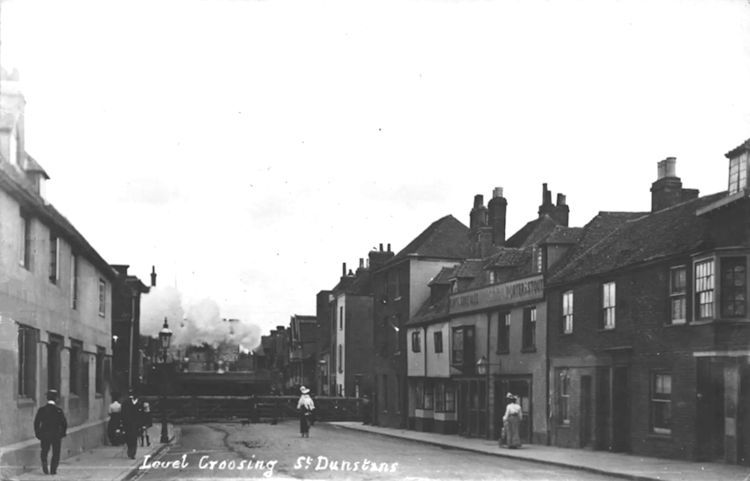
Above postcard, 1907, kindly sent by Rory Kehoe. As a S.E. Railway
locomotive steams out of Canterbury West Station, the Unicorn proudly
advertises itself as a tied house within the estate of Flint & Co's St.
Dunstan's Brewery, which was located just a couple of metres behind the
photographer's left shoulder. Although not designated as the brewery
tap, the Unicorn is the closest pub to the 16th century Roper Gateway,
which was served as both the main entrance to Flint's Brewery.
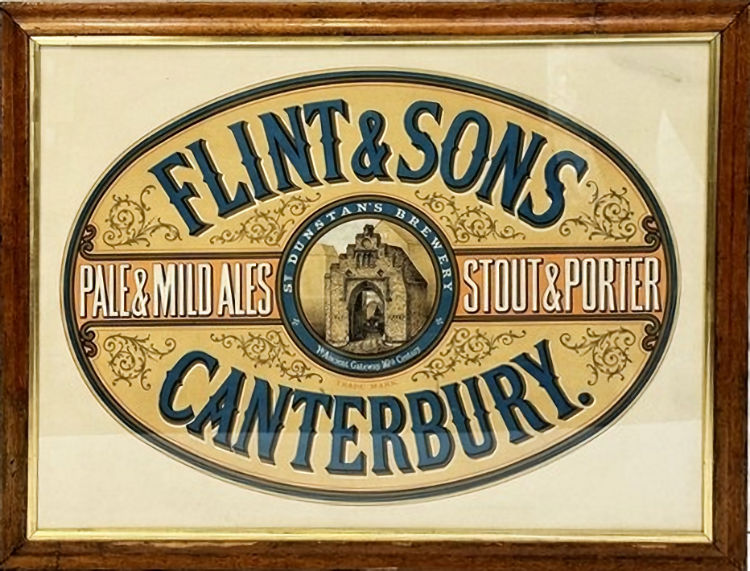
Above showing a Flint & Son's advertising poster (a copy of which is
on display in the Unicorn) which dates from around 1895. |
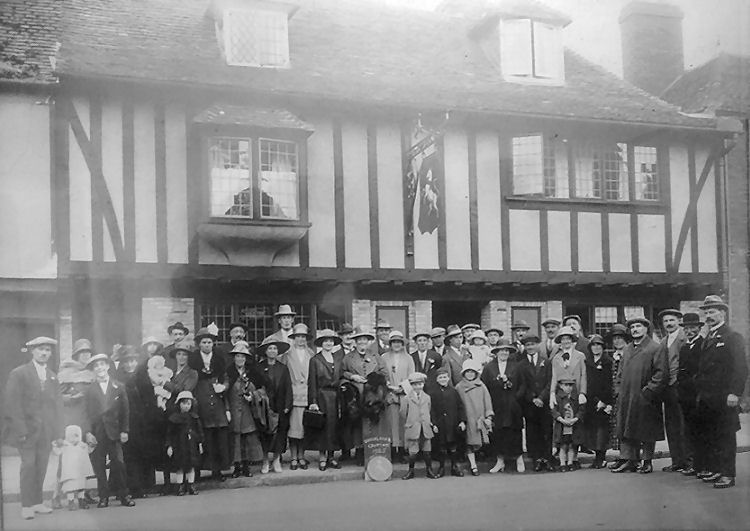
Above photo, 1925, kindly sent by Rory Kehoe. |
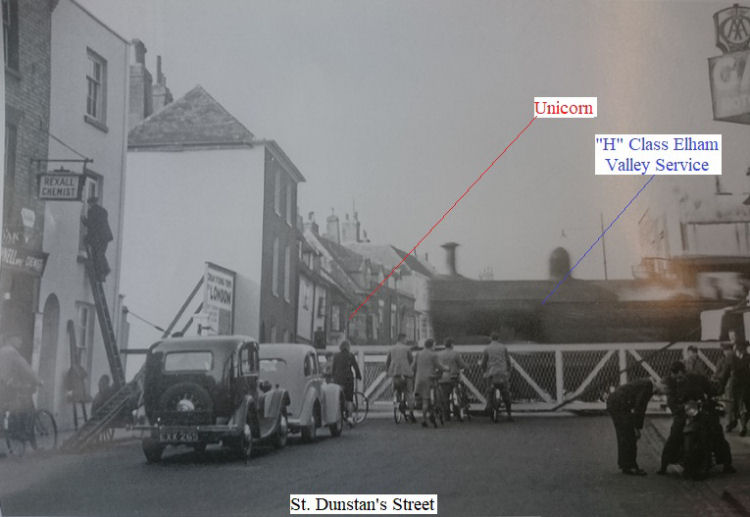
Above photo, 1935, kindly sent by Rory Kehoe. |
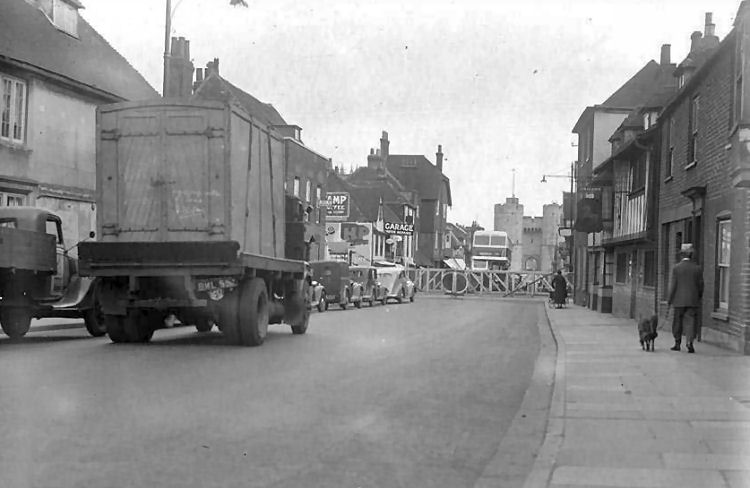
Above photo, circa 1949, kindly sent by Rory Kehoe. |

Above photograph by Edward Wilmot 1965. |
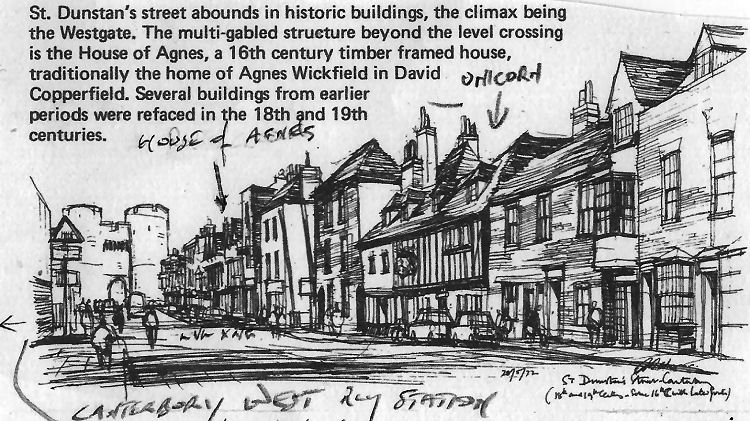
Above print from "City of Canterbury Streets and Buildings," drawing by
John Berbiers. 28 May 1972. |

Above photo circa 1991. |
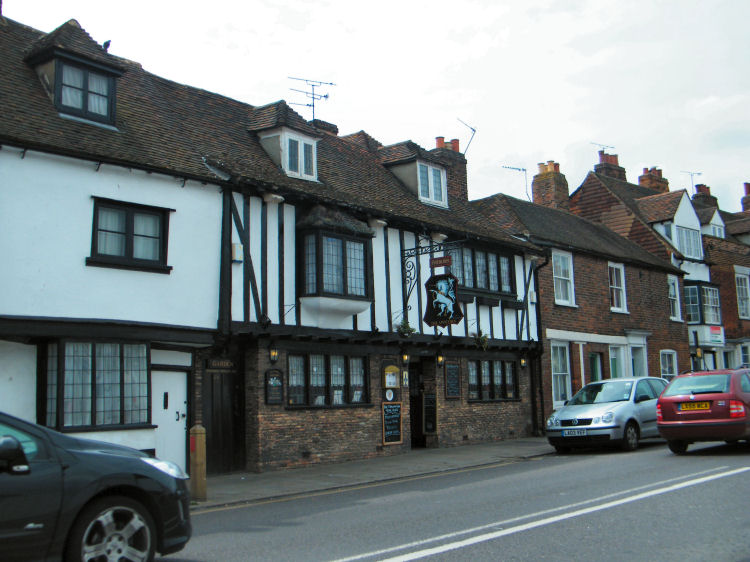
Above photo taken by Paul Skelton, 19 May 2012.
|
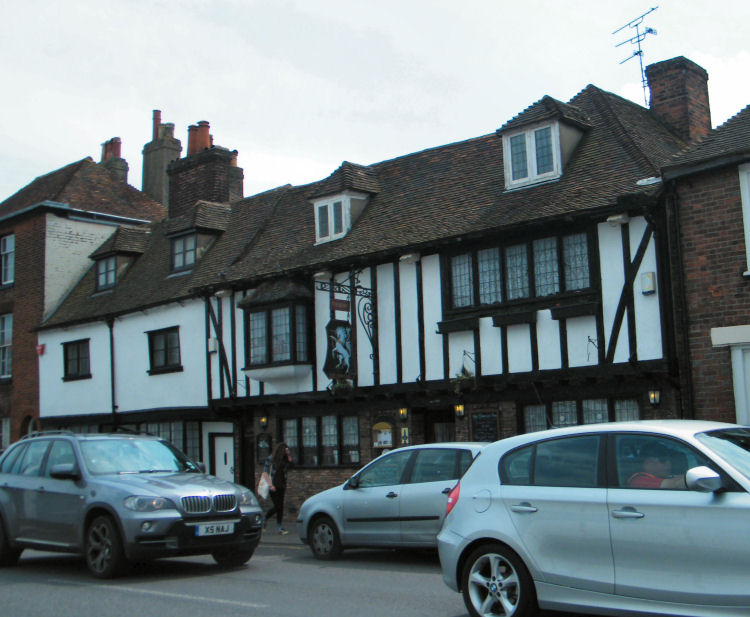
Above photo taken by Paul Skelton, 19 May 2012. |
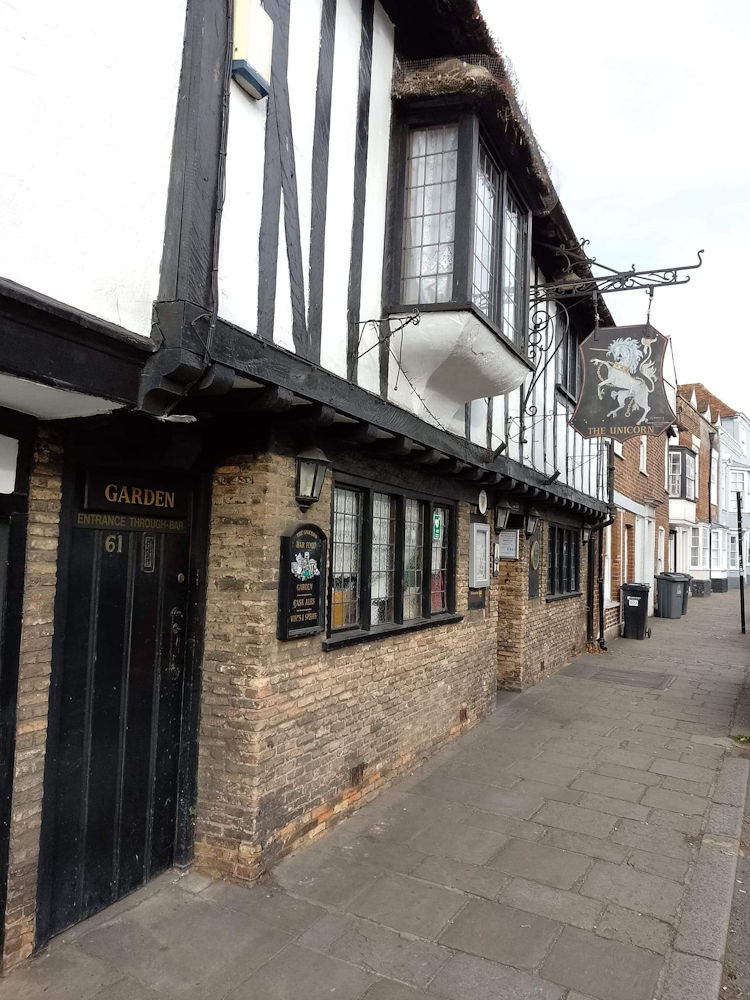
Above photo, circa 2023. |
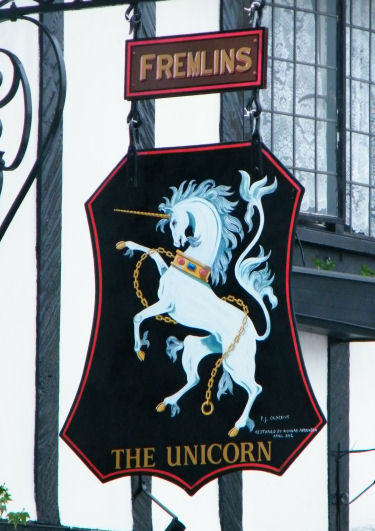 
Above sign left taken by Paul Skelton, 19 May 2012.
Unicorn sign right 1980.
|
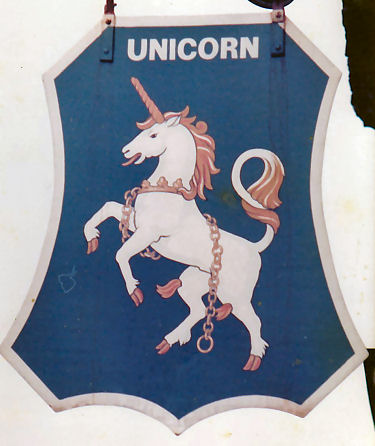 
Unicorn sign left 1980s, and the sign on the right July 1991
Above with thanks from Brian Curtis
www.innsignsociety.com
|
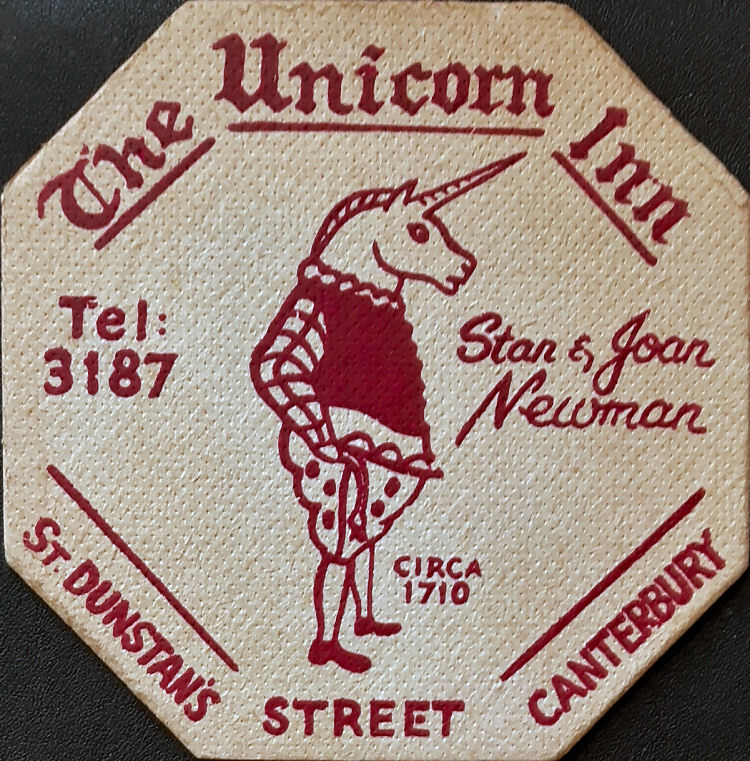
Above beermat 1960s, kindly sent by Mike L. |

Drawing above taken from innsociety website, date unknown. |
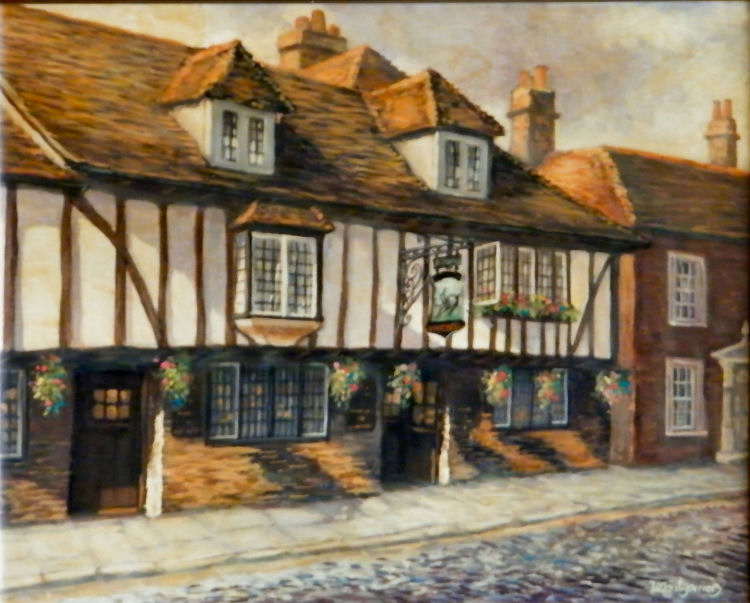
Painting above taken from a picture hanging inside the pub, date unknown. |
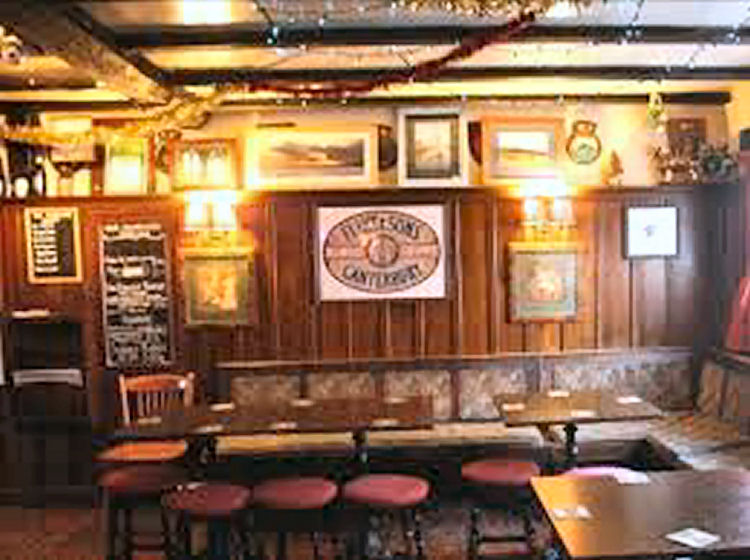
Above photo, circa 2017, kindly sent by Rory Kehoe. |
I believe this pub was called the "Star"
from between 1740 and 1860 but started off as the "Unicorn" and changed back
to the "Unicorn."
This was at one time a Flint & Son's tied house, whose St. Dunstan's
Brewery was just over the road.
|
Information taken from their web site. A picture frame
inside the pub also holds the same information
This inn known as the name and sign of the "Unicorn" was built in the 35th year of
Elizabeth I, in 1593. Though this original structure has at different
intervals of time undergone alteration.
When first built the property was a dwelling house, owned by one
Robert Budden, a woollen drayper of Canterbury. He held title to this
and two other properties in the City, a messuage in Burgate Street and
another in Kingstreet (now Best Lane) until his death in the final year
of James I, in 1625, whereafter only a 'widow Buddenne' is recorded
here. By 1638, she had sold this house to one Solomon Buesden, a leather
merchant of Canterbury, who it appears conducted the business of buying
and selling hides from the house for many years to follow.
By 1661, Buesden had died and the property had been passed to his son
Isaac a leather seller of St Dunstan's, who was carrying on the family
business. However in 1664 he applied for and was granted a licence to
sell ales from the premises, which at first bore no title other than
that of an ale house in St Dunstan's and that Isaac Buesden, a leather
seller and now tapster was of that house. He kept the house until his
death in 1692, whereafter it passed to his son Jacob. In that same year
he registered the house under the title of "The Unicorn"'.
Jacob Buesden kept "The Unicorn" until 1708. In that year he sold it
to Thomas Snelling, a shoemaker of Canterbury. He kept it for only a
short while before selling in 1712, and moving to Beercart lane, where
he had a shoemaking business for many years to follow. "The Unicorn" was
purchased by Henry Nat Vile. In that year he made a successful
application before the justices at Canterbury and was granted a full
licence for the house. He kept it until his death in 1736, where-after
his daughter Susannah, inherited it and all it contained, by the terms
of his will. She is recorded as a milliner by trade and appears to have
conducted this business, beside the day to day running of "The Unicorn".
Susannah Sorrell sold "The Unicorn" in 1741, to Stephen Stokes who in
that same year changed the name of the house to that of "The Star".
However this proved unpopular, for in the following year he changed it
back again to "The Unicorn". He kept the house until 1763, selling it in
that year to Phillip Watson. A brewer of Longport and by 1765 one
Zacharia Powell was keeping the house on a lease, he had purchased from
him. Powell kept it until 1772, handing over in that year to Wiliam
Norris, a cutler of North Lane. By the time he left in 1780, Phillip
Watson had sold the house to Francis Giles who was also a brewer of
Longport.
Nathan Salmone took over the lease and stayed until 1787, being
succeeded in that year by James L. Fisher. Before the close of the 18th
Century there followed three other innkeepers. In 1794, Thomas Sewell,
in 1796, Frederick Solley and in 1799, Thomas Patcher. It was whilst in
the hands of the latter that "The Unicorn" gained the reputation of
being a 'bawdy house'. Between 1802 and 1808 certain affrays took place
in this house and as a result of which complaints were made and the
offenders charged as follows:- In May 1802, one called Venn described as
a ruffian was charged with assaulting a women called Sedgegrove for
which he was sentenced for three months in Canterbury Prison, in 1804
Timothy Johns was ordered to pay a fine of 4 pounds or go to prison for
one month for insulting the landlord Patcher, in 1805 one called
Rawlings was fined 5 pound for drunkenness and insulting behaviour, and
on the last occasion in 1808 after an affray between a miller called
Adams and a carpenter called Potter, over the repute of a women called
Grissen, Thomas Patcher was himself brought before magistrates and fined
8 pounds for keeping 'a disorderly and bawdy house'.
In 1810, Patcher gave up "The Unicorn" to Thomas Wraight, and in
1815, Mrs Eliza Giles sold to Flint and Kingsford brewers of St
Dunstan's. Wraight in 1817, was succeeded by John Holmes who kept the
house until 1833, being succeeded by Isaac Ratcliffe, whose brother
Richard was a bootmaker of St Dunstan's. Ratcliffe was succeeded in 1851
by Alfred Foreman, he in 1865 by James Partiss, he in 1873 by James
Roberts, he in 1889 by George Jordan, he in 1894 by William Benson, he
in 1897 by George Blackman, he in 1902 by James Draper and whilst in his
hands the Flint Brewery sold to Leney's in 1923 who were
eventually taken over by Whitbread, Fremlin. Draper left in 1912 being
succeeded by George Minter, he in 1921 by Charles Fisk, he in 1923 by
William Best, he in 1932 by Henry Callow and he in 1937 by Cyril Gerrard.
He Stayed until 1958 when he was succeeded by Edward Evans, he in 1959
by Frederick Evans and he in 1960 by Donald Stanley White, and he in
1961 by Stanley Newman, he in 1967 by Bernard George Acton, being
succeeded in 1982 by John Frank Balcombe, who was succeeded 1997 by the
present keepers Lorenzo Domenico Carlo and Emma Louise Carnevale-Maffe',
joined by David and Donatella Wilkinson in 2006.
The qualities attributed to the "Unicorn" caused this animal to be
used as a sign both by chemists and goldsmiths. It was believed that the
only way to capture it was to leave a handsome young virgin in one of
the places where it resorted. As soon as the animal had perceived her,
he would come and lie quietly down beside her, resting his head in her
lap, and fall asleep, in which state he might be surprised by the hunter
who watched for him. This laying the head in the lap of a virgin made
the first Christians choose the Unicorn as the type of Christ born from
the Virgin Mary.
The horn, as an antidote to all poison, was also believed to be
emblematic of the conquering or destruction of sin by the Messiah.
Religious emblems being in great favour with the early printers, some of
them for this reason adopted the Unicorn as their sign; thus John
Harrison lived at the UNICORN AND BIBLE in Patercoster Row, 1603. Again,
the reputed power of the horn caused the animal to be taken as a
supporter for the apothecaries arms, and as a constant signboard by
chemists.
Whatever it was that passed for Unicorn's horn (probably the horn of
a Narwhal), it was sold at an immense price. "The Unicorn whose horn is
worth 7 city," says Decker in his Gull's Hornbook; and Andrea Racei, a
Florentine physicist, relates that it had been sold by the apothecaries
at £24 per once, when the current value of the same quantity of gold was
only £2 3s. 6d. In a MS table of Customs entitled, "The Book of Rates in
ye first years of Queen Mary 1531," we find the duty paid upon "Cornn
unicorni ye once 20s."
An Italian author who visited England in the reign of Henry the
Seventh, speaking of the immense wealth of the religious houses in the
country says:- "And I have been informed that, amongst other things,
many of these monasteries possess unicorns' horns of an extraordinary
size." Hence such a horn was fit to be placed among the royal jewels,
and there it appears at the head of an inventory taken in the first year
of Queen Elizabeth, and preserved in Pepys's Library. "Imprimis, a piece
of unicorn's horn," which, as the most valuable object, is named first.
There was no doubt that the piece was seen by the German traveller
Hentzner, at Windsor: "Wewere shown here, among other things, the horn
of a unicorn of about eight spans and a half in length, valued at above
£10,000." Peacham places "that horne of Windsor (of an unicorne very
likely)" among the sights worth seeing. Fuler also speaks of a unicorn's
horn - "in my memory shown to people in the Tower" and enters on a long
dissertation about its virtues; but it seems to have been lost, or at
least, no longer exhibited in his time.
The belief in the efficacy and value of this horn continued to the
close of the seventeenth century; for the Rev. John Ward in his diary,
p.172 says:- "Mr. Hartman had a piece of unicorn's horn, which one Mr.
Godeski gave him; hee had itt att some foraine prince's court. I had the
piece in my hand. Hee desired Dr. Willis to make use of itt in curing
his agne; but the Dr. refusd because hee had never seen itt used. Mr.
Hardman told me the forementioned gentleman had as much of itt as would
make a cup, and hee intended to make one of itt. I approved ittself as a
true one, as hee said by this; if one drew a circle with itt about a
spider she would not move out of it."
The great value set upon Unicorn's horn caused the goldsmiths to
adopt the animal as their sign. There is one recorded in Machyn's Diary:
the first of May, 1561, "at afternone dyd Mastyr Godderyke's sone the
goldsmyth go hup into hys father's gyldng house, toke a bowe-strynge,
and hanged ymselff at the syne of the Unycorne in Chepewyd." In 1711 the
UNICORN AND DIAL was the sign of the watchmaker near the Strand Bridge.
|
Originally a dwelling house in the 16th century and owned by Robert
Budden, a woollen draper. The ale licence being granted about 1650.
Listed in the 1692 licensing list and the following year offering
billeting for 4 soldiers.
1763 the building was sold to Longport Brewer, Philip Watson but in the
18th century it was twice mentioned as being a "Bawdy house" and it gained a
bad reputation.
|
Oxford Journal, Saturday 28th August 1756.
Country News. Canterbury, August 21.
Thursday evening, about 7 o'clock, the mistress of the "Unicorn" Ale
House in this city, carried her child to bed, which was about 15 months
old; and about 9, the Maid Servant hearing the child cry very much, went
to see what was the matter; when, to her great surprise, she found it
very bloody; and, on searching of it, discovered that it had been bit in
several places, which, all that have seen the child, conclude to be done
by rats; the quantity of blood was found in the bed.
|
|
From the Kent Herald, 8 March 1827.
DEATH.
March 4, in St. Dunstan's Canterbury, Edward, third son of Mr. J. Holness, of
the "Unicorn" public-house.
|
|
From the Kent Herald, 4 October 1827.
DEATH.
Sept. 30, in St. Dunstan's, Canterbury, George, fourth son of Mr. Holness,
landlord of the "Unicorn." This is the second bereavement Mr. Holness has
experienced within six months.
|
|
From the Kentish Gazette, 29 August 1865.
Offending Public Houses.
At the City Petty Sessions, yesterday, Superintendent Davies
reported that he found people drinking in the "Unicorn" public-house,
St. Dunstun, at five minutes before 11 o’clock on Sunday morning,
and some men in the skittle alley of the "Royal Dragoon," Military
Road, at 20 minutes past 12. He also complained of certain
irregularities at the "Lord Clyde," Military-road. The Magistrates
directed that the keepers of the houses be directed to attend the
Court on Thursday.
|
|
From the Kentish Gazette, Friday 5 September, 1865.
OFFENDING PUBLICANS.
John Partis, landlord of the "Unicorn" public house, St. Dunstan's was
charged with having company drinking in his house at 10.55 a.m. on
Sunday, the 27th ultimo. Superintendent Davies stated that he visited
the house at the time named, and found seven men and one woman drinking.
There were eight men, but one of them turned out to be a lodger. Mrs.
Partis, who appeared for her husband, produced a list of the names of
the people in the house when Mr. Davies called, to show that they were
travellers who had just arrived in the city by train. Some of them were
from Pluckley, others from Ramsgate, and two from Preston. Mr. Davies
said the case was one in which he wished to obtain a conviction, as the
house was generally conducted in an unsatisfactory manner. After a brief
consultation the Magistrates decided that, as there was some doubt about
the case, they would dismiss it.
|
|
From the Kentish Gazette, Friday 5 September, 1865.
ROBBING LODGINGS.
Yesterday, at the City Police Court (before William Plummer, Esq.,
William Masters, Esq., Edward Holttun, Esq., and Alderman Philpott) an
old man named James Thorpe, charged, on remand from Friday, with
stealing a lace shawl, value £1, the property of Mr. Partis, landlord of
the "Unicorn," St. Dunstan Street, was sentenced to be imprisoned a
month with hard labour.
It appeared that on Thursday night the prisoner
obtained lodgings at the "Unicorn," and on Friday morning left early,
between seven and eight o'clock on Friday morning the prisoners went
into the "Kent Arms"
public house, and asked a little boy named William
Martin, if he would sell him a paper to wrap a parcel in. The lad
refused, and seeing the prisoner had a shawl similar to the one he knew
belonged to Mrs. Partis, he suspected it was hers, and gave her
information of the fact. She, on searching her house, found the shawl
was missing, and went after the prisoner and found him in the
"Falstaff." She accused him of taking her shawl, and he said he had not
got it, he then went away, and Mr. Smith, the landlord produced her
shawl to her, which the prisoner had left in his care. Information was
given to the police, and P.S. Elvey took possession of the shawl, and
apprehended the prisoner in St. Peter's Street.
|
|
From the Whitstable Times and Herne Bay Herald. 29 June 1867. Price 1d.
BREAKING A WINDOW.
At the City Police Court, on Monday, Thomas Ockford, who stated that he
was traveller to a firm of book publishers, was charged with wilfully
breaking a pane of glass in the house of Mr. Partis, landlord of the
“Unicorn,” St. Dunstan's. The case was dismissed, on payment of amount
of damage. |
|
From the
http://www.kentonline.co.uk 30 July 2016.
Firefighters called to St Dunstan's Street, Canterbury, after blaze in pub.
Four fire engines were called to St Dunstan's in Canterbury after a fire
broke out in one of the street's pubs.
The fire service rescued a man in his 50s from the first floor of the
Unicorn close to the level crossing.
They had been called at 3.45am on Saturday after reports of a fire on
the ground floor, which is believed to have started in the kitchen.
Paramedics treated the rescued man for minor smoke inhalation.
He was given oxygen therapy, but did not need to go to hospital.
|
|
From the
http://www.morningadvertiser.co.uk 30 July, 2016.
Fire ravages kitchen of CAMRA award-winning pub.
"Firefighters rescued a man from a Kent pub after its kitchen burst into
flames early on Sunday morning (30 July)."
Four fire engines raced to the Unicorn Inn in Canterbury after reports
came in that the pub was on fire and a man was trapped in the building.
The man, reported to be in his 50s or 60s, was retrieved from the
building and treated for smoke inhalation by paramedics. However, they
deemed hospital treatment was not required.
Speaking to the Kent & Sussex Courier, Blue Watch manager Mike
Godden said the whole street had been filled with smoke.
Godden told the local paper: “Another crew put in a search of the
building but there were no other people inside. The fire was brought
under control pretty quickly, but crews remained at the scene until 7am
to damp down and cut away damaged areas of the building.”
A fire investigation crew called to the scene reported that an
electrical fault in a kitchen appliance was to blame for the blaze.
The pub’s kitchen was completely destroyed.
Following the fire, a post on the Unicorn Inn's Facebook page read:
Thank
you for all your kind words and offers of help. We now have power
restored and we are cleaning up as much as we can.
We will be open tomorrow as usual, but with a slight whiff of smoke in
the air. As for food, it's bring your own until things are sorted.
The Unicorn Inn was previously named CAMRA pub of the year in 2014 for
the Canterbury, Herne Bay and Whitstable area and featured in the
organisation’s 2016.
Good Beer Guide
|
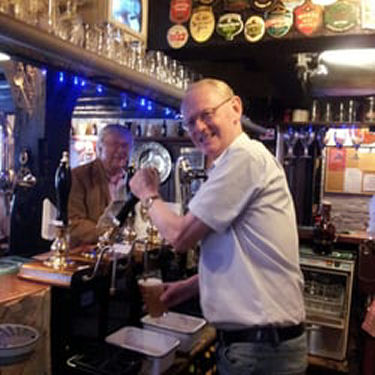
Above photo, Circa 2012 showing David Wilkinson behind the bar, kindly
sent by Rory Kehoe. I am told Dave was the man who was rescued from the pub
fire and is now retired and missed by his regulars. |
During the Covid 19 crisis of 2020, this pub was able to offer a take
away service in June, possibly earlier.
LICENSEE LIST
BUESDEN Isaac 1664-92 (Ale house no name)
BUESDEN Jacob 1692-1708 (Son of above and named pub "Unicorn.")
SNELLING Thomas 1707-12
VILE Henry Nat 1712-36
SORRELL Suzannah (daughter of above) 1736-41
STOKES Stephen 1741+
STOKES Stephen 1742-63
WATSON Phillip 1763-65
POWELL Zacharia 1765-72
NORRIS William 1772-1780
GILES Francis 1780-87
SALMONE Nathan 1787
FISHER James L 1787-94
SEWELL Thomas 1794-96
SOLLEY Frederick 1796-99
PATCHER Thomas 1799-1810
WRAIGHT Thomas 1810-17
HOLMES/HOLNESS John 1817-33
 
FURNER Richard 1832-40+
  
RATCLIFFE Isaac 1833-51

FOREMAN Alfred 1851-65
PARTIS Richard James 1858-74+
    ( ( John)
John)
ROBERTS James 1873-89
(age 53 in 1881 ) ) 
JORDAN George 1889-94

BENSON William 1894-97
BLACKMAN George 1897-1902
DRAPER James 1902-12
 
HARVER Frank 1913

MINTER George 1912-21
FISK Charles Henry 1921-23

BEST William Henry A 1923-32

CALLOW Henry 1932-37
GERRARD/GERARD Cyril W 1837-58

EVANS Edward 1958-59
EVANS Frederick 1959-60
WHITE Donald Stanley 1960-61
NEWMAN Stanley 1961-67
ACTON Bernard George 1967-82
BALCOMBE John Frank 1982-97
CARLO Lorenza Domenico & CARNEVALE-MAFFE Emma Louise 1997-2006
CARLO Lorenza Domenico & CARNEVALE-MAFFE Emma Louise & WILKINSON David
and Donatella 2006-16+
https://pubwiki.co.uk/Unicorn.shtml
 From the Pigot's Directory 1824 From the Pigot's Directory 1824
 From the Pigot's Directory 1828-29 From the Pigot's Directory 1828-29
 From the Pigot's Directory 1832-33-34 From the Pigot's Directory 1832-33-34
 Stapleton's
Guide 1838 Stapleton's
Guide 1838
 From the Pigot's Directory 1840 From the Pigot's Directory 1840
 From Bagshaw Directory 1847 From Bagshaw Directory 1847
 From Melville's Directory 1858 From Melville's Directory 1858
 From the Post Office Directory 1862 From the Post Office Directory 1862
 Greens
Canterbury Directory 1868 Greens
Canterbury Directory 1868
 From the Post Office Directory 1874 From the Post Office Directory 1874
 Census Census
 From the Post Office Directory 1882 From the Post Office Directory 1882
 From the Post Office Directory 1891 From the Post Office Directory 1891
 From the Post Office Directory 1903 From the Post Office Directory 1903
 From the Post Office Directory 1913 From the Post Office Directory 1913
 From the Post Office Directory 1922 From the Post Office Directory 1922
 From the Kelly's Directory 1903 From the Kelly's Directory 1903
 From the Post Office Directory 1930 From the Post Office Directory 1930
 From the Post Office Directory 1938 From the Post Office Directory 1938
 Historic
Canterbury web site www.machadoink.com Historic
Canterbury web site www.machadoink.com
|


















